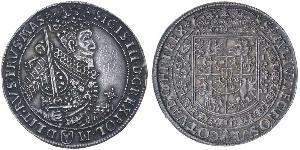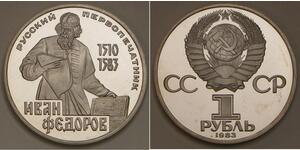1 Thaler Holy Roman Empire (962-1806) Silver Ferdinand II, Holy R ...
1636, Nuremberg (Free City), Ferdinand II. Beautiful Silver Thaler Coin Mint Year: 1636 Reverse: Imperial crown above nimbate double-headed imperial eagle. Legend with titles of Ferdinand II around. For your consideration a beautiful, rare and early silver thaler, struck by the City of Nuremberg (Nürnberg), with the titles of Emperor Ferdinand II, who was one of the key-figures during the 30-Years war and the main supporter of the Holy League (the catholic anti-protestant alliance). A rare German States civic issue, certified NGC! Nuremberg is a city situated on the Pegnitz river and the Rhine-Main-Danube Canal. It is located about 170 kilometres north of Munich. The cultural flowering of Nuremberg in the 15th and 16th centuries made it the center of the German Renaissance. In 1525, Nuremberg accepted the Protestant Reformation, and in 1532, the religious Peace of Nuremberg, by which the Lutherans gained important concessions, was signed there. In 1632 during the Thirty Years' War, the city, occupied by the forces of Gustavus Adolphus of Sweden, was besieged by the army of Imperial general Albrecht von Wallenstein. A devout and very pious Catholic, his recognition as King of Bohemia and suppression of Protestantism precipitated the early events of the Thirty Years' War, and he remained one of the staunchest backers of the Anti-Protestant Counter Reformation efforts as one of the heads of the German Catholic League, prolonging the Thirty Years' Wars by insisting the Edict of Restitution be enforced. The duration of his reign was occupied by confessional and military concerns, and some historians blame him for the large civilian loss of life in the Sack of Magdeburg in 1631, as he’d instructed Count Tilly to enforce the edict upon Saxony—his orders causing Tilly to move the Catholic armies east, ultimately to Leipzig, where they suffered their first substantial defeat at First Breitenfeld. Emperor Matthias died in Vienna in March 1619. As earlier agreed, Ferdinand succeeded him on the throne. Supported by the Catholic League, which included the rulers of Poland, Spain, and Bavaria, Ferdinand sought to reclaim his Bohemian possessions and stamp out the Protestant rebellion. On November 8, 1620, Catholic forces engaged those supporting the Protestant Frederick, who had taken the Bohemian kingship, at the Battle of White Mountain. After only two hours of fighting, the Catholics emerged victorious. The now-deposed Frederick fled to the Netherlands and Duke Maximilian I of Bavaria, the leader of the Catholic League, moved to confiscate his lands in the Palatinate. The restored Ferdinand set about strengthening the Catholic church in Bohemia, reduced the authority of the Diet, and forcibly converted Austrian and Bohemian Protestants. By 1625, despite receiving subsidies from the Spanish and the Pope, Ferdinand was strapped for cash and looking for a means to raise his own army. His solution was to charge the Bohemian soldier and “military entrepreneur” Albrecht von Wallenstein with raising and commanding an Imperial army. Wallenstein accepted the position with the proviso that the management (and possession) of the army’s funds were solely his, as was the right to take and distribute loot and ransoms taken in the course of operations. Quickly raising at least 30,000 men (he would later command at least 100,000), and fighting alongside the Catholic League army under the Count of Tilly, Wallenstein defeated Protestant forces in Silesia, Anhalt, and Denmark. With his forces scoring important victories against the Protestants, Ferdinand crowned his religious policies by issuing his Edict of Restitution (1629), which was designed to restore all ecclesiastical properties which had been secularized since the Peace of Passau in 1552. This blatantly pro-Catholic policy has been widely credited with bringing the Protestant King of Sweden, Gustavus Adolphus, into the war against Ferdinand. Despite the successes of Wallenstein, many of Ferdinand’s advisors saw a genuine political threat in the general, citing his growing influence, his increasing number of estates and titles, as well as his extortionate methods of raising funds for his army. Ferdinand responded by dismissing Wallenstein in 1630. With the loss of his commander, he was once again forced to rely on the Catholic League army under Tilly, who was unable to stem the Swedish advance and was killed in 1632. As a result, Ferdinand recalled Wallenstein from retirement. In the spring of 1632, Wallenstein raised a fresh army in a matter of weeks and drove the Protestant army out of Bohemia. In November came the great Battle of Lützen, at which the Catholics were defeated, but Gustavus Adolphus was killed. Wallenstein withdrew to winter quarters in Bohemia. Although he had lost strategically and been forced out of Saxony, the Protestants had suffered much greater casualties. The campaigning of 1633 was indecisive, partly because Wallenstein was negotiating with the enemy, thinking that the army would be loyal to him, rather than Ferdinand, and follow him if he switched sides. In early 1634, he was openly accused of treason and assassinated at Eger, probably at Ferdinand’s instigation. Despite the loss of Wallenstein, Imperial forces took Regensburg and won a victory at the Battle of Nördlingen. Swedish strength was greatly weakened, but France entered the war on the side of the Protestants out of fear of Habsburg domination. Although the country was Catholic, France feared both the Germans and the Spanish, so Cardinal Richelieu convinced King Louis XIII of France to ally himself with the Dutch and the Swedes. The French were highly dissatisfied with the terms of the Peace of Prague concluded in 1635, the last important act of Ferdinand. Therefore, although a treaty was signed, peace did not come. At Ferdinand’s death in 1637, his son Ferdinand III inherited an embattled empire.
A lovely coin, struck during the Thirty Years' War!
Denomination: Thaler
Mint Master: Georg Nurnberger
Reference: Davenport 5654, KM-134 ($900 in XF!).
Mint Place: Nuremberg (as free city within the Holy Roman Empire).
Weight: 28.85gm
Diameter: 42mm
Material: Silver
Obverse: Standing half-nude cupid with palm- and olive-sprays in hands, leaning on two filiated shields with arms of Nurnberg. A third shield with arms of the Holy Roman Empire above, date (16-36) split in fields.
Legend: MONETA NOVA ARGENT : REIPVB : NORIMBERG +
Legend: FERDINANDVS . II . D . G .. ROM . IMP . SE . AU .. GE .. HU . BO .. Rx Ferdinand II, Holy Roman Emperor (July 9, 1578 – February 15, 1637), of the House of Habsburg, reigned as Ferdinand II, Archduke of Inner Austria (normally called Ferdinand II of Germany when referred to as Archduke) and Holy Roman Emperor from 1619-1637. He was also the Archduke of Styria (Inner Austria) from 1590–1637, King of Bohemia from 1617-1619 and again from 1620-1637, as well as King of Hungary and Croatia from 1618-1625. The expansion of the ongoing acts of rebellion against his Imperial Governors in Bohemia on May 23rd, 1618 directly triggered the Thirty Years' War, and can be blamed on his religious intolerance toward Protestants.
Ferdinand II, Holy Roman Emperor (July 9, 1578 – February 15, 1637), of the House of Habsburg, reigned as Ferdinand II, Archduke of Inner Austria (normally called Ferdinand II of Germany when referred to as Archduke) and Holy Roman Emperor from 1619-1637. He was also the Archduke of Styria (Inner Austria) from 1590–1637, King of Bohemia from 1617-1619 and again from 1620-1637, as well as King of Hungary and Croatia from 1618-1625. The expansion of the ongoing acts of rebellion against his Imperial Governors in Bohemia on May 23rd, 1618 directly triggered the Thirty Years' War, and can be blamed on his religious intolerance toward Protestants.
(1737 X 848 pixels, file size: ~338K)
Posted by: anonymous 2023-10-30
1636, Nuremberg (Free City), Ferdinand II. Beautiful Silver Thaler Coin. NGC AU+A lovely coin, struck during the Thirty Years' War! Mint Year: 1636Denomination: ThalerMint Master: Georg Nurnberger Reference: Davenport 5654, KM-134 ($900 in XF!). Condition: Certified and graded by NGC a ...
(900 X 458 pixels, file size: ~117K)
Posted by: anonymous 2015-11-16
Nürnberg, Stadt Taler 1635. Genius mit drei Stadtwappen / Doppeladler mit Brustschild. Kellner 250, Davenport 5654. Sehr schön
2 Liard Austrian Netherlands (1713-1795) Copper
group has 3 coins / 3 prices
⇑
1 Ruble USSR (1922 - 1991) Copper/Nickel
group has 6 coins / 5 prices
⇑

-500-250-S08hwJflYCIAAAGLyfpTnYK4.jpg)
-300-150-S08hwJflYCIAAAGLyfpTnYK4.jpg)
-300-150-iUUKbzbiqWEAAAFRbMtauw5A.jpg)






-300-150-zTgKbzbixN4AAAFSpQBzJO3T.jpg)

-300-150-mnLBwcI0dU4AAAEmQ3EdQQfM.jpg)






